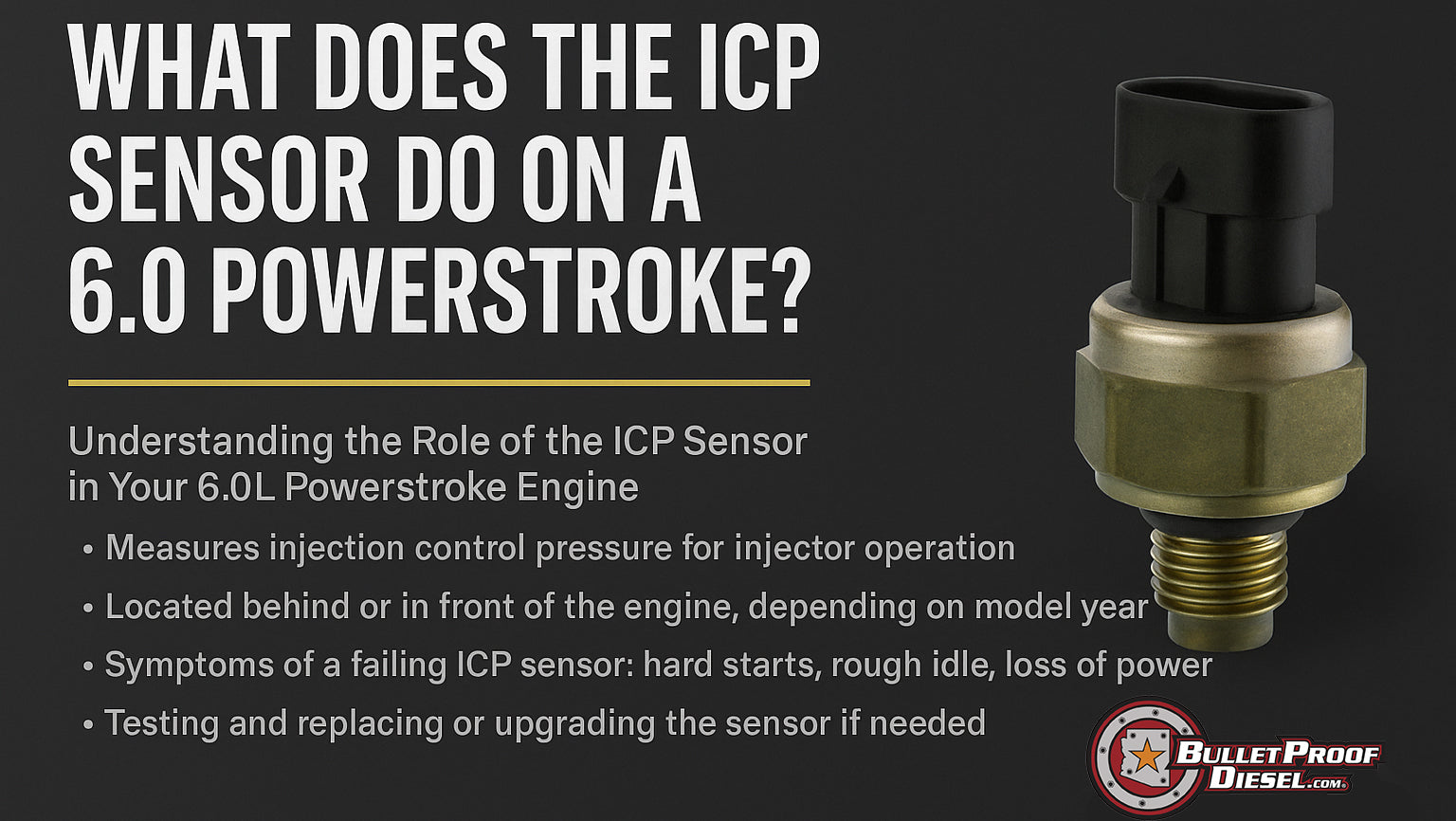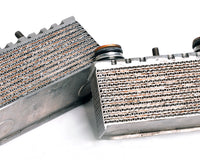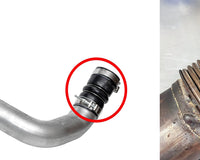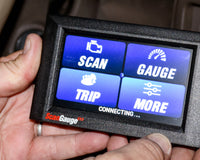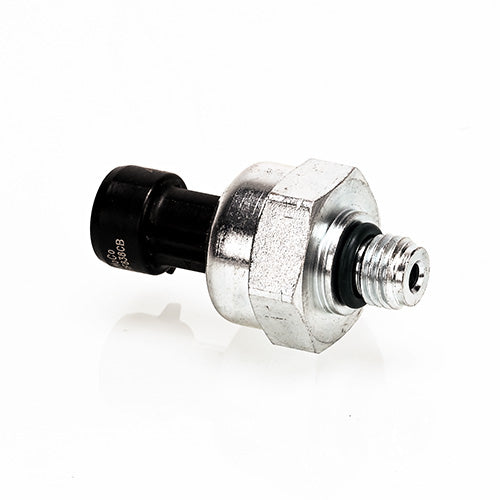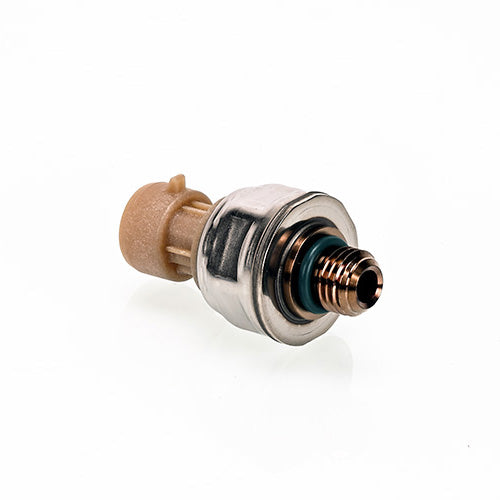Understanding the Role of the ICP Sensor in Your 6.0L Powerstroke Engine
The 6.0L Powerstroke is a powerful and popular diesel engine used in Ford Super Duty trucks from 2003 to 2007. While known for its performance, the engine relies heavily on its electronic and hydraulic systems. One key component in this system is the ICP (Injection Control Pressure) sensor. As you can see in the circuit below, the system appears to be fairly simple, however everything has to be operating perfectly for maximum performance and efficiency. 
At Bullet Proof Diesel, we've diagnosed and resolved countless drivability issues caused by ICP sensor failures. From hard starts to rough idling or complete no-start conditions, a malfunctioning ICP sensor can be a hidden culprit. Understanding what this sensor does and how to spot problems early can help prevent costly repairs and downtime.
In this article, we’ll explain what the ICP sensor does on a 6.0 Powerstroke, where it’s located, how to test it, and when it should be replaced.
What Is the ICP Sensor?
The ICP sensor is a three wire variable capacitance sensor. The PCM (Powertrain Control Module) supplies a 5 volt reference signal which the ICP sensor uses to produce a linear analog voltage that indicates pressure. The higher the return voltage, it is assumed by the PCM, the higher the pressure in the high pressure oil system. The PCM monitors ICP as the engine is operating to modulate the IPR (Injection Pressure Regulator). The PCM continuously monitors and adjusts using the IPR valve, for ideal ICP determined by conditions such as load, speed and temperature.
If the PCM picks up that the ICP is less than or greater than desired, it may set a trouble code for several different ICP related codes. These trouble codes are discussed more later on in this article. The ICP signal from the PCM is one of the signals the FICM (Fuel Injection Control Module) uses to command the correct injection timing.
The ICP sensor plays a critical role in the 6.0L Powerstroke’s Hydraulic Electronic Unit Injector (HEUI) fuel system. Its primary function is to measure the pressure in the high-pressure oil rail, which drives the fuel injectors.
This pressure data is sent to the Powertrain Control Module (PCM), which uses it to manage injection timing and fuel quantity. If the sensor fails or sends inaccurate data, the PCM cannot control injector function correctly, leading to issues like:
-
Poor performance
-
Hard starts
-
No-start conditions
- Black Smoke
Though small, the ICP sensor has a big impact on engine operation and reliability. At Bullet Proof Diesel, we frequently consider this component when diagnosing a poor performing 6.0 Powerstroke.
Where Is the ICP Sensor Located on a 6.0 Powerstroke?
The ICP sensor's location varies by model year:
-
2003–2004 models: Located behind the turbocharger (a major pain to access)
-
2005–2007 models: Moved to the front of the engine near the passenger-side valve cover (easier to service)

Accessing the sensor may require removing parts like the turbo or degas bottle, especially on early models. Bullet Proof Diesel recommends inspecting both the sensor and its pigtail connector during diagnostics, as both are known failure points.
Symptoms of a Failing ICP Sensor
Common signs of ICP sensor failure include:
-
Hard starts or no-start conditions
-
Rough/Erratic idling or stalling
-
Loss of engine power under load
-
Poor fuel economy
-
Inaccurate oil pressure readings via scan tools
You may also see diagnostic trouble codes (DTCs) such as:
-
P2285 – ICP sensor circuit low
-
P2286 – ICP sensor circuit performance
-
P2287 – ICP sensor circuit intermittent
While these symptoms can point to other issues as well, accurate testing is crucial before replacing components.
How to Test the ICP Sensor on a 6.0 Powerstroke
Testing typically requires a diagnostic scan tool that reads live data. Key readings include:
-
Key On, Engine Off (KOEO): Voltage should be approximately 0.2–0.25 volts
-
While cranking: Voltage should rise to at least 0.8 volts to allow starting
Tools like FORScan, AutoEnginuity, or other professional-grade diagnostic devices can help monitor these values. If voltages are out of spec or erratic, the sensor or its wiring may be faulty.
Don’t forget to check the ICP pigtail. Oil contamination or damaged wires can lead to signal issues.
Should You Replace or Upgrade the ICP Sensor?
If tests confirm the sensor is faulty, replace it with a high-quality, OEM-spec unit. Cheap aftermarket alternatives often cause inaccurate readings and poor drivability.
At Bullet Proof Diesel, we recommend using OEM or approved replacement sensors that meet or exceed factory specs. Also inspect and if needed, replace the pigtail connector, especially if there’s any sign of oil intrusion or corrosion. Addressing both components at once can prevent future headaches.
Maintenance Tips to Prevent ICP Sensor Issues
To prolong the life of your ICP sensor:
-
Use high-quality engine oil with the proper viscosity
-
Follow recommended oil change intervals
-
Inspect the ICP sensor and pigtail during regular maintenance
-
If your truck has over 150,000 miles and the ICP sensor has not already been replaced, consider proactively replacing the sensor
Staying ahead of ICP sensor problems can save you from sudden no-start situations or poor engine performance.
Final Thoughts: Why the ICP Sensor Matters
Though small, the ICP sensor is critical to your 6.0 Powerstroke's performance. As the bridge between oil pressure and injector control, it ensures smooth, reliable engine operation.
Failing to recognize a faulty sensor can lead to wasted time and money chasing the wrong issues. At Bullet Proof Diesel, we’ve helped thousands of Powerstroke owners restore performance by properly diagnosing and resolving ICP sensor problems.
If you're noticing drivability issues or performing routine maintenance, don’t overlook this vital component. Correct testing and the use of high-quality parts can make all the difference.
Disclaimer:
This content is provided by Bullet Proof Diesel for informational purposes only. Always consult your owner’s manual or a qualified diesel technician before performing any repairs or replacements.

